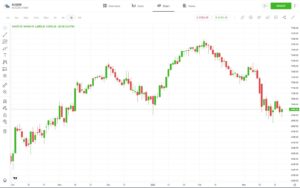It was another volatile week on global share markets, with the ASX200 declining for the seventh straight week. Real Estate was the worst-performing sector falling by 3% for the week, whilst financials were also a drag on the market, falling 1.89%. Overseas though, it was slightly better news, with the S&P500 up 1.4% and the Nasdaq climbing 2%.
3 things that happened last week:
1. Federal Reserve raises rates by another 25 basis points
Last week, the Federal Reserve raised its cash rate by another 25 basis points in what the market now believes will be the last hike of this current cycle. Target rate probabilities by CME Group show a more than 70% chance that the Federal Reserve will leave the cash rate unchanged at its next meeting on May 3rd. However, the Fed is still concerned about inflation and although markets are anticipating a pause, Jerome Powell and other Fed members that more needs to be done in order to return inflation to target.
2. Bitcoin gains for 2nd straight week
It was another week of gains for bitcoin (BTC), with the asset benefiting from the outlook for a quicker fall in inflation and interest rates. The asset has soared 70% this year, making it the best-performing asset class for the 11th time in its 14-year existence. The top-down macro outlook remains the main crypto driver for now with investors feeling more confident taking on risk with the rate hike expectations falling significantly from their peak. However, there are risks if the Federal Reserve does stay more aggressive than what the market has accounted for, which could see some broad weakness across crypto markets.
3. A winner and loser last week from the S&P/ASX200
It was a great weak for gold miner Evolution Mining (EVN) after the company announced it was three months ahead of its new project in New South Wales. The news excited investors, with shares climbing by 14% for the week.
On the other hand, payments provider Block (SQ) had a tough week, with its shares tumbling by more than 20%. The fall comes after a scathing report from Hindenburg Research, a well-known short-seller.
3 things to watch for the week ahead:
1. Rate Hike expectations dialled down, investors take on more risk.
Last week saw the 7th straight decline for the ASX200, its worst run for over a decade. With the US banking crisis tightening financial conditions, markets anticipate that the Federal Reserve could be done with its jumbo rate hike cycle. This has significantly impacted the local market as investors take on more risk with tech stocks and rotate away from defensive assets that dominate the ASX200. For context, the technology sector makes up just 2.7% of the ASX200, whilst financials, one of the worst-performing sectors this year, makes up a massive 28%. The likely peaking of interest rates and lower inflation outlook supports risk assets and has also helped boost crypto, with bitcoin soaring 70% this year. Ultimately, this could mean more weakness for the local market as the rotation continues, but the positive is that investors won’t be willing to completely give up their safe haven stocks just yet, with the inflation fight globally still not over.
2. Australian Monthly CPI: Was December the peak?
This week (Mar. 29), Aussie Investors will be hoping to see another decline in inflation. After January’s reading of 7.4%, the Reserve bank of Australia has stated that inflation has peaked, raising investor hopes that a pause in its tightening cycle is in sight. Expectations are for February’s monthly inflation reading to come in at 7.1%, falling significantly from December’s peak of 8.4%. The full effect of the RBA’s ten consecutive hikes are yet to be felt, and the board continues to have a tricky task in walking the fine line between bringing down inflation and not tipping the Australian Economy into recession. However, looking overseas, we can see that it’s not plain sailing to get inflation under control. UK inflation is stubbornly high, with all readings since September coming in above 10%. The recent overseas banking crisis has also thrown a spanner in the mix for the RBA, but board members quickly reassured consumers this week that banks were unquestionably strong.
3. Retail Sales for February: Are high inflation and rising rates squeezing Aussies?
Retail spending bounced back in January after plunging in December, but investors will be looking this week (Mar. 28) to see if that resilience can continue. After months of continued spending, high inflation and rising rates are squeezing Australian consumers. The RBA will be looking towards retail sales and hoping for another slowdown in spending, particularly as their tone has turned dovish in recent weeks. Household spending accounts for around 60% of GDP, and strong sales will be key to Australia’s growth this year, but the follow-through from the RBA’s consecutive rate hikes may dampen consumer spending. Ultimately, consumer sales will be patchy throughout 2023, and consumers will more than welcome an end to the RBA’s tightening cycle.
*All data accurate as of 27/03/2023. Data Source: Bloomberg and eToro
Disclaimer:
This communication is general information and education purposes only and should not be taken as financial product advice, a personal recommendation, or an offer of, or solicitation to buy or sell, any financial product. It has been prepared without taking your objectives, financial situation or needs into account. Any references to past performance and future indications are not, and should not be taken as, a reliable indicator of future results. eToro makes no representation and assumes no liability as to the accuracy or completeness of the content of this publication.




